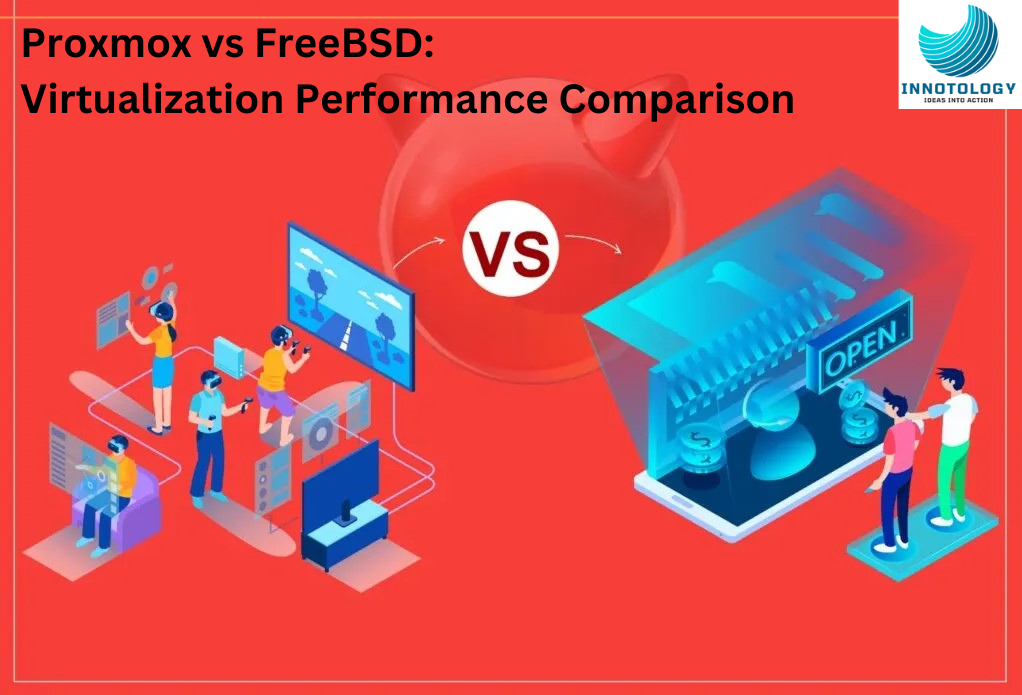Performance is a key consideration when selecting a virtualization host. In order to ascertain which of two well-known virtualization solutions—Proxmox and FreeBSD—offers better performance, this essay analyzes both. Proxmox VE is a popular choice in business settings due to its strong management features. Another good option is FreeBSD, which has sophisticated networking and security capabilities. This comparison will assess how well they perform on a number of measures giving you information to assist you choose the best choice for your unique virtualization requirements.
What is Proxmox
An open-source virtualization management system made for business use is called Proxmox Virtual Environment (VE). Users can manage virtual machines and containers using a single interface because of its integration of KVM (Kernel-based Virtual Machine) and LXC (Linux Containers) technologies.High availability, live migration backup and restore extensive networking choices are among the capabilities that Proxmox VE provides. It is a well-liked option for companies wishing to effectively deploy and maintain virtualized systems because of its strong performance, user-friendliness, and comprehensive documentation.
What is FreeBSD
The Berkeley Software Distribution (BSD) Unix is the source of the sophisticated open-source operating system known as FreeBSD. It is well known for its performance, dependability and sophisticated networking, security and storage capabilities. FreeBSD provides a powerful virtualization platform that supports a number of hypervisors including Xen and Bhyve. It is a popular option for servers and embedded systems due to its wealth of documentation, vibrant community and lengthy industrial history. The flexibility and modularity of FreeBSD enable tailored deployments that meet a range of virtualization requirements.
Comparative Analysis
To decide which virtualization host performs better, here is an analysis of the key findings:
Investigation of CPU and RAM Data Interpretation
FreeBSD has superior memory performance while Proxmox offers more reliable CPU performance. The specific workload requirements and the comparative relevance of consistent performance against increased throughput may determine which of Proxmox and FreeBSD is best.
Tests of I/O Performance
The performance information gathered from various Proxmox and FreeBSD settings offers a comprehensive overview of the I/O capabilities and identifies some key distinctions.
Host Physical Systems and Filesystems
VM Configurations Comparison :
File Creation Speed: Amid VMs, VM on FreeBSD (ZFS, NVMe) leads, followed by VM on FreeBSD (zvol) and then VM on FreeBSD (ZFS, Virtio).
Read and Write Operations per Second: VM on FreeBSD (ZFS, NVMe) and VM on FreeBSD (zvol) both outperform VM on Proxmox (ZFS) and VM on Proxmox (LVM) configurations expressively.VM on Proxmox (ZFS) outperforms VM on Proxmox (LVM) in read and write operations.
fsync Operations per Second: VM on FreeBSD (ZFS, NVMe) and VM on FreeBSD (zvol) have significantly advanced fsync operations compared to VM on Proxmox (ZFS) and VM on Proxmox (LVM).
Throughput: VM on FreeBSD (ZFS, NVMe) and VM on FreeBSD (zvol) have the highest throughput followed by VM on Proxmox (ZFS) and then VM on Proxmox (LVM).
Latency: VM on FreeBSD (ZFS, NVMe) and VM on FreeBSD (zvol) display the lowest latencies among the VMs indicating faster response times.
VM on Proxmox (ZFS) shows lower latencies compared to VM on Proxmox (LVM).
Cache Settings and Performance Influence: Cache settings can considerably influence the performance of virtualization systems. The performance differences may be also due to how diverse operating systems manage the caches of NVMe devices.
Key insights
Regarding RAM and CPU, the VMs’ performance is similar; there are slight variations favoring Proxmox for CPU and FreeBSD for RAM, but I don’t think these would influence the choice between the two solutions. The I/O performance data clearly shows that VM on FreeBSD with NVMe and ZFS performs significantly better than all other configurations, as demonstrated by the file creation speed, read/write operations per second, fsync operations per second, throughput and latency metrics. On the other hand, the VM on FreeBSD with NVMe and ZFS shows that there may be a fundamental problem, such as the NVMe driver not honoring fsync correctly, which could lead to theThis could lead to the VM believing that data has been written when it has not, resulting in artificially inflated performance results.
When comparing physical hosts, Host FreeBSD (ZFS) demonstrates excellent performance, mainly in comparison to Host Proxmox (ZFS) and Host Proxmox (ext4).
The best-performing virtual machines (VMs) are those running on FreeBSD (ZFS, NVMe) and FreeBSD (zvol) configurations. The possibility of a fsync problem with NVMe storage must be taken into account. FreeBSD configurations beat both, however VM on Proxmox (ZFS) performs better than VM on Proxmox (LVM).
Strong performance is also shown by the FreeBSD virtual machine running Virtuo, however not as well as the NVMe setup. While keeping comparable latencies, it performs noticeably better than Proxmox configurations in terms of throughput, read/write operations per second, and file creation speed.
Wrap up
In conclusion, it is crucial to look into the possible problem with fsync operations even though the FreeBSD virtual machine with NVMe and ZFS exhibits the best performance.
Users can optimize their systems for specific workloads and performance requirements by carefully examining these performance metrics and making well-informed decisions regarding their storage and virtualization setups.
Given the foregoing discussion, Proxmox is unquestionably a reliable solution with a wealth of capabilities battle-tested functionality and many other strong qualities. However, FreeBSD particularly when combined with the nvme driver, exhibits extremely high performance and a very minimal overhead in both installation and operation.
- Earn money online: The Best Ways to Make Money Online in 2024 - February 1, 2025
- CloudWatch: Your AWS Monitoring Hub - January 3, 2025
- Level Up Your API Documentation: Top 10 Tools for 2025 - January 1, 2025

